For the municipality, see Meteora (municipality). For other uses, see Meteora (disambiguation).
| Meteora | |
|---|---|
| Native name Μετέωρα (Greek) | |
 Landscape of Meteora Landscape of Meteora | |
| Location | Trikala, Thessaly, Greece |
| Coordinates | 39°42′51″N 21°37′52″E / 39.71417°N 21.63111°E / 39.71417; 21.63111 (Meteora) |
| Area | Thessaly |
| UNESCO World Heritage Site | |
| Official name | Meteora |
| Type | Cultural |
| Criteria | i, ii, iv, v, vii |
| Designated | 1988 (12th session) |
| Reference no. | 455 |
| Region | Europe |
 | |
Download coordinates as:
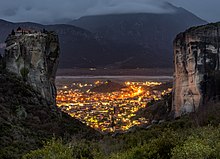
The Meteora (/ˌmɛtiˈɔːrə/; Greek: Μετέωρα, pronounced [meˈteora]) is a rock formation in the regional unit of Trikala, in Thessaly, in northwestern Greece, hosting one of the most prominent complexes of Eastern Orthodox monasteries, viewed locally as second in importance only to Mount Athos. Twenty-four monasteries were established atop the giant natural pillars and hill-like rounded boulders that dominate the local area, mainly from the second half of the 14th century under the local rule of Simeon Uroš. Six of these are still active and open to visitors: the monasteries of Great Meteoron (est. 1356), Varlaam, Saint Nicholas Anapausas, Rousanou, Holy Trinity, and Saint Stephen. The latter became a community of nuns in 1961, whereas the former five remain managed by monks.
Meteora is located in between the town of Kalabaka and the village of Kastraki at the northwestern edge of the Plain of Thessaly near the Pineios river and Pindus Mountains. The Meteora complex was added to the UNESCO World Heritage List in 1988 because of its outstanding architecture and beauty, combined with religious and cultural significance.
The name means "lofty", "elevated", and is etymologically related to meteor.
Geology
Beside the Pindos Mountains, in the western region of Thessaly, these unique and enormous columns of rock rise precipitously from the ground. But their unusual form is not easy to explain geologically. They are not volcanic plugs of hard igneous rock typical elsewhere, but the rocks are composed of a mixture of sandstone and conglomerate.
The conglomerate was formed of deposits of stone, sand, and mud from streams flowing into a delta at the edge of a lake, over millions of years. About 60 million years ago during the Paleogene period a series of earth movements pushed the seabed upward, creating a high plateau and causing many vertical fault lines in the thick layer of sandstone. The huge rock pillars were then formed by weathering by water, wind, and extremes of temperature on the vertical faults. It is unusual that this conglomerate formation and type of weathering are confined to a relatively localised area within the surrounding mountain formation. The complex is referred to an exhumed continental remnant of Pangean association.
This type of rock formation and weathering process has happened in many other places locally and throughout the world, but what makes Meteora's appearance special is the uniformity of the sedimentary rock constituents deposited over millions of years leaving few signs of vertical layering, and the localised abrupt vertical weathering.
Excavations and research have discovered petrified diatoms in Theopetra Cave, which have contributed to understanding the Palaeo-climate and climate changes. Radiocarbon dating evidences human presence dating back 50,000 years. The cave used to be open to the public, but is currently closed indefinitely, for safety inspections.
Vegetation grows thickly out of the vertical rock walls, mainly due to the water that one is able to find in the cracks and crevices that scale the cliff. Over the past several hundred years, the reports that the Meteora was easily accessible by foot have changed because now one must pass through an impenetrable jungle.
Being such massive unpredictable rock pillars, rock falls pose a constant threat to pilgrims and tourists of Meteora. An earthquake of magnitude 7 on the Richter Scale shook the rocks in 1954; miraculously the thin pillars still stand today. In 2005, a massive rock fell, closing the access road leading up to Meteora for days.
History
Archaeology
See also: Theopetra CaveTheopetra Cave is located 4 kilometres (2.5 mi) from Kalambaka. Its uniqueness from an archeological perspective is that a single site contains records of two greatly significant cultural transitions: the replacement of Neanderthals by modern humans and later, the transition from hunting-gathering to farming after the end of the last Ice Age. The cave consists of an immense 500 square metres (5,400 sq ft) rectangular chamber at the foot of a limestone hill, which rises to the northeast above the village of Theopetra, with an entrance 17 metres (56 ft) wide by 3 metres (9.8 ft) high. It lies at the foot of the Chasia mountain range, which forms the natural boundary between Thessaly and Macedonia regions, while the Lithaios River, a tributary of the Pineios River, flows in front of the cave. The small Lithaios River flowing literally on the doorsteps of the cave meant that cave dwellers always had easy access to fresh, clean water without the need to cover daily long distances to find it.
Ancient history
Caves in the vicinity of Meteora were inhabited continuously between 50,000 and 5,000 years ago. The oldest known example of a built structure, a stone wall that blocked two-thirds of the entrance to the Theopetra cave, was constructed 23,000 years ago, probably as a barrier against cold winds (Earth was experiencing an ice age at the time), and many paleolithic and neolithic artifacts of human occupation have been found within the caves.
Meteora is not mentioned in classical Greek myths, nor in Ancient Greek literature. The first people who were documented to inhabit Meteora after the Neolithic Era were an ascetic group of hermit monks who, in the 800s CE, moved up to the ancient pinnacles. They lived in hollows and fissures in the rock towers, some of them as high as 1800 ft (550m) above the plain. This great height, combined with the sheerness of the cliff walls, kept away all but the most determined visitors. Initially, the hermits led a life of solitude, meeting only on Sundays and special days, to worship and pray in a chapel built at the foot of a rock known as Dupiani.
As early as the eleventh century, monks occupied the caverns of Meteora. However, monasteries were not built there until the 1300s, when the monks sought somewhere to hide in the face of an increasing number of attacks by the Turks upon Greece. At this time, access to the top was via removable ladders or hoisting ropes. Currently, getting up there is much simpler, due to steps having been carved-into the rock during the 1920s. Of the 24 monasteries, only six (four of men, two of women) are still functioning, with each housing fewer than ten individuals.
History and construction of the monasteries
The exact date of the establishment of the monasteries is widely believed to be unknown. However, there are clues to when each of the monasteries was constructed. By the late eleventh century and early 1100s, a rudimentary monastic state had formed, called the Skete of Stagoi, and it was centerd around the still-standing church of Theotokos (Mother of God). By the end of the 1100s, an ascetic community had flocked to Meteora.
In 1344, Athanasios Koinovitis from Mount Athos, later known as Athanasios the Meteorite, brought a group of followers to Meteora. From 1356 to 1372, he founded The Monastery of Great Meteoron on the Broad Rock. That location was perfect for the monks, because there, they were safe from political upheaval, and they had complete control of the entry to the monastery. The only means of reaching it was by climbing a long ladder, which was drawn-up whenever the monks thought that there was a threat to them. The creation of the monastic community at Meteora was protected and sponsored by the local lord Simeon Uroš, based in nearby Trikala, who in 1356 had proclaimed himself Emperor of Serbs and Greeks following the death of Stefan Dušan.
Simeon Uros was succeeded in 1370 by his son John Uroš, who three years later retired as a monk to the Meteoron monastery and died there in the early 1420s. At the end of the fourteenth century, Christian rule over northern Greece was being increasingly threatened by Turkish raiders who wanted control over the fertile plain of Thessaly, which they finally secured in the second half of the 15th century. The hermit monks, seeking a retreat from the expanding Ottoman empire, found the inaccessible rock pillars of Meteora to be an ideal refuge. More than 20 monasteries were built, of which six remain today. In 1517, Theophanes built the monastery of Varlaam, which was reputed to house the finger of St. John and the shoulder blade of St. Andrew.
Access to the monasteries was originally (and deliberately) difficult, requiring either long ladders that were latched together, or large nets that were used to haul-up both goods and people. This required quite a leap of faith, because the ropes were replaced, so the story goes, only "when the Lord let them break". In the words of UNESCO: "The net in which intrepid pilgrims were hoisted up vertically alongside the 373 metres (1,224 ft) cliff where the Varlaam monastery dominates the valley symbolizes the fragility of a traditional way of life that is threatened with extinction."
Until the 1600s, the primary means of conveying goods and people from these high places was by means of baskets and ropes.
Under the Convention of Constantinople (1881), Thessaly was taken-over by the Kingdom of Greece. In 1921, Queen Marie of Romania visited Meteora, becoming the first woman ever allowed to enter the Great Meteoron monastery.
In the 1920s, there was an improvement in the arrangements: Steps were cut into the rock, making the complex accessible via a bridge from the nearby plateau. During World War II, the site was bombed.
List of rocks

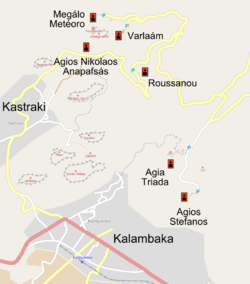
There are various rocks of Meteora that surround the village of Kastraki and border the north side of the main town of Kalabaka. The height in metres is also given for various rocks.
- Dupiani (Δούπιανη; 390 m (1,280 ft))
- Agio Pneuma (Άγιο Πνεύμα; 600 m (2,000 ft)), site of the historic Monastery of St. George of Mandila [bg] and Monks' Prison
- Kumaries (Κουμαριές; 497 m (1,631 ft))
- Toichos Alpha (Τοίχος Α) / Kafkasia (480 m (1,570 ft))
- Toichos Beta (Τοίχος Β) / Sfika (528 m (1,732 ft))
- Toichos Gamma (Τοίχος Γ) / Palaiokranies (540 m (1,770 ft))
- Toichos Delta (Τοίχος Δ) / Lianomodia (531 m (1,742 ft))
- St. Eustratius (Αγίου Ευστρατίου)
- Archangel (Ταξιαρχών)
- Chalasma (Χάλασμα)
- Marmaro (Μάρμαρο; "marble"), traversed by a paved road that connects Kastraki with Kalabaka
- Surloti (Σουρλωτή; 600 m (2,000 ft))
- Modi (Μόδι; 584.5 m (1,918 ft)), site of the historic Monastery of St. Modestus
- Alysos (Άλυσος) / Altsos (Άλτσος) / Alsos (Άλσος) (587.8 m (1,928 ft)), site of the historic Monastery of the Apostle Peter's Chains
- Pyxari (Πυξάρι; 523.9 m (1,719 ft)), site of the historic Hermitage of Saint Gregory the Theologian [bg] (Ασκηταριά Αγίου Γρηγορίου του Θεολόγου), Monastery of St. Anthony, and Monastery of Chrysostomos
- Badovas (Μπάντοβας; 447.3 m (1,468 ft)), site of the historic Monastery of St. Nicholas of Badovas [bg]
- Ambaria (Αμπάρια; 400 m (1,300 ft))
- Agia (Αγιά; 630 m (2,070 ft)), also known as Megali Agia, or "Large Aya". Site of the historic Monastery of St. Apostoles (Μονή Αγίων Αποστόλων).
- Mikri Agia (Μικρή Αγιά), or "Small Aya"
- Adrachti (Αδράχτι; 474 m (1,555 ft))
- Ftelias (Φτελιάς)
- St. Dimitrios (Αγίου Δημητρίου), where the Monastery of St. Dimitrios and Ypapantis Monastery can be found
- Kelarakia (Κελαράκια)
- Psaropetra ("Fish Rock"), now a viewpoint on the main road that is popular with tourists
The greater Meteora rock formation also extends northwest into the Gavros and Agios Dimitrios areas, although the term Meteora is commonly used to refer to only the rocks around Kalabaka and Kastraki.
The Monasteries of Meteora
At their peak in the 16th century, there were 24 monasteries at Meteora in Greece. They were created to serve monks and nuns following the teachings of the Eastern Orthodox Church. Much of the architecture of these buildings is Athonite in origin. Today there are six still functioning, while the remainder are largely in ruin. Perched onto high cliffs, they are now accessible by staircases and pathways cut into the rock formations.
List of monasteries
Traditionally, the 24 historic monasteries of Meteora are listed as follows. Coordinates are also given for some sites. The list is primarily sourced from Vlioras (2017), with some additional notes from Provatakis (2006).
| English | Greek transliteration | Greek script | Notes | Image |
|---|---|---|---|---|
| Monastery of the Holy Archangels [bg] | Agion Taxiarchon | Αγίων Ταξιαρχών | Monastery ruins (39°43′01″N 21°38′09″E / 39.717067°N 21.635697°E / 39.717067; 21.635697 (Monastery of the Holy Archangels)) on Archangel (Taxiarchon) Rock (Βράχος Ταξιαρχών). | |
| Monastery of the Apostle Peter's Chains | Alyseos Apostolou Petrou | Αλύσεως Αποστόλου Πέτρου | Probably built around 1400. Ruins (39°42′46″N 21°37′46″E / 39.712752°N 21.629524°E / 39.712752; 21.629524 (Monastery of the Apostle Peter's Chains)) on Alysos (Άλσος) Rock. | 
|
| Monastery of the Pantocrator | Pantokratora | Παντοκράτορα | Mentioned in documents from 1650. Ruins (39°43′20″N 21°37′17″E / 39.722293°N 21.621406°E / 39.722293; 21.621406 (Monastery of the Pantocrator)) at the Dupiani area. It is located about 30 metres above the ground. | 
|
| Monastery of St. John of Bunilas | Ioannou tou Bounela | Ιωάννου του Μπουνήλα | Ruins of monastery walls in an area called Bunila, known as Palaiomonastiro (Παλαιομονάστηρο). | |
| Monastery of St. John the Baptist | Agiou Ioanne Prodromou | Αγίου Ιωάννη Προδρόμου | Founded in the mid-17th century. Ruins (39°43′25″N 21°37′26″E / 39.723732°N 21.624006°E / 39.723732; 21.624006 (Monastery of St. John the Baptist)) located on a rock directly adjacent to the Monastery of St. Nicholas Anapausas. The rock on which the monastery was built was the residence of Athanasius the Meteorite. Theophanes and Nektarios Apsarades, the founders of the Monastery of Varlaam, also lived on the rock for seven years before they built Varlaam. | 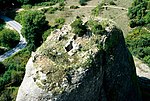
|
| Ypsilotera Monastery / Kalligrafon | Mones Ypseloteras / Kalligrafon | Μονής Υψηλωτέρας / Καλλιγράφων | The monastery was famous for its manuscripts and calligraphers. Founded in 1347 by Paschalis of Kalambaka. Ruins (39°43′30″N 21°37′40″E / 39.725090°N 21.627798°E / 39.725090; 21.627798 (Ypsilotera Monastery)) located on Ypsilotera Rock (585.7 m) next to the "Devil's Tower", a geological rock formation that is between the Monastery of St. Nicholas Anapausas and Monastery of Varlaam. In the photo to the left, Ypsilotera is the free-standing dome-shaped rock on the left, covered with vegetation on top. | 
|
| Kallistratou Monastery | Kallistratou | Καλλιστράτου | Exact location uncertain. In the general area of the Monastery of St. Nicholas Anapausas and Monastery of Rousanou. Also known as the Monastery of Christ the Savior (Μονὴ Σωτῆρος Χριστοῦ, Moni Sotiros Christou). | |
| Panagia of Mikani Monastery (Paleopanagia) | Panagias tes Mekanes / Palaiopanagia | Παναγίας της Μήκανης / Παλαιοπαναγιά | Founded in 1358 in a rock cave (39°48′8″N 21°40′42″E / 39.80222°N 21.67833°E / 39.80222; 21.67833 (Palaiopanagia Monastery)). 7 km north of Vlachava village, near the Ion (or Mikani) River, a tributary of the Pineios. It can be reached via a dirt road that goes out to the northeast from the village center of Vlachava. A carved staircase leads up to the rock cave. Elevation: about 600 m. Also, directly behind it lies Kallistra Rock (βράχος Καλλίστρα), the site of the ruins of the Monastery of St. Kallistos (Μονή Αγίων Αποστόλων Καλλίστου), which is also called the Monastery of the Holy Apostles (Μονή των Αγίων Αποστόλων). | |
| Monastery of Great Meteoron | Metamorfoses | της Μεταμόρφωσης | One of the 6 open monasteries today. | 
|
| Monastery of Rousanou / Arsanou | Rousanou / Arsanou | Ρουσάνου / Αρσάνου | One of the 6 open monasteries today. | 
|
| Monastery of St. Anthony | Agiou Antoniou | Αγίου Αντωνίου | Built around the 14th century, only a small church has survived from the monastery (39°42′44″N 21°37′18″E / 39.712166°N 21.621643°E / 39.712166; 21.621643 (Monastery of St. Anthony)), on the south side of Pyxari Rock. | 
|
| Monastery of Varlaam / All Saints | Varlaam / Agion Panton | Βαρλαάμ / Αγίων Πάντων | One of the 6 open monasteries today. | 
|
| Monastery of St. George of Mandila [bg] | Agiou Georgiou tou Mandela | Αγίου Γεωργίου του Μανδηλά | Ruins at the Holy Spirit (Agion Pnefma) Rock (39°43′06″N 21°37′21″E / 39.718336°N 21.622516°E / 39.718336; 21.622516 (Monastery of St. George of Mandila)). Kerchiefs (mandilia) are traditionally hung at the cave entrance. The cave is 15 metres long and 4–5 metres deep at its center, and is located about 30 metres above the ground. It may have been one of the four monasteries founded around 1367 by Neilos, the Prior of the Skete of Stagoi. The Cave of St. George of Mandila may be the same as the Cave of Archimandrite Makarios near Pigadion. | 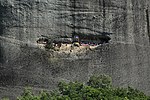
|
| Monastery of St. Gregory [bg] | Agiou Gregoriou | Αγίου Γρηγορίου | Founded in the 14th century. Ruins (39°42′44″N 21°37′18″E / 39.712271°N 21.621536°E / 39.712271; 21.621536 (Monastery of St. Gregory)) on Pyxari Rock. | 
|
| Monastery of St. Dimitrios | Agiou Demetriou | Αγίου Δημητρίου | Destroyed by Ali Pasha Tepelena in 1809 since Greek insurgents led by Thymios Vlachavas had set up their headquarters in the monastery. Ruins (39°44′00″N 21°37′52″E / 39.7332099°N 21.6310140°E / 39.7332099; 21.6310140 (Monastery of St. Dimitrios)) on Dimitrios Rock above Ypapantis Monastery. | 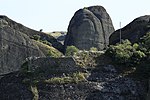
|
| Monastery of St. Modestus | Agiou Modestou | Αγίου Μοδέστου | Built around the 12th century. First mentioned in a 12th-century letter. Also mentioned in 1614. Ruins (39°42′53″N 21°37′46″E / 39.714796°N 21.629437°E / 39.714796; 21.629437 (Monastery of St. Modestus)) on Modesto (Modi) Rock (rock on the right in the photo). | 
|
| Holy Monastery | Agias Mones | Αγίας Μονής | The monastery was mentioned in 1614, which at the time was inhabited by more than 20 monks. Ruins (39°43′26″N 21°37′41″E / 39.723969°N 21.627943°E / 39.723969; 21.627943 (Holy Monastery)) in the Sterna area near Ypsilotera Monastery. The monastery had also sought to gain recognition as a stavropegion. | 
|
| Monastery of St. Nicholas of Badova / Nikolaus Kofina | Agiou Nikolaou tou Bantova / Agiou Nikolaou Kofina | Αγίου Νικολάου του Μπάντοβα / Αγίου Νικολάου Κοφινά | Founded c. 1400 in a rock cave on Badovas Rock. Not preserved, since in 1943 it was bombed and destroyed by the Germans. Ruins (39°42′39″N 21°37′20″E / 39.710731°N 21.622125°E / 39.710731; 21.622125 (Monastery of St. Nicholas of Badova)), which can be reached via a series of ladders passing through three caves, located at the southwestern edge of the Meteora rock complex. | 
|
| Monastery of St. Nicholas Anapausas | Agiou Nikolaou Anapausa | Αγίου Νικολάου Αναπαυσά | One of the 6 open monasteries today. | 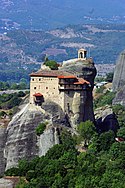
|
| Monastery of St. Stefanos | Agiou Stefanou | Αγίου Στεφάνου | One of the 6 open monasteries today. | 
|
| Monastery of the Holy Trinity | Agias Triados | Αγίας Τριάδος | One of the 6 open monasteries today. | 
|
| Monastery of the Holy Apostles | Agion Apostolon | Αγίων Αποστόλων | Ruins have been preserved (39°42′42″N 21°37′31″E / 39.711703°N 21.625157°E / 39.711703; 21.625157 (Monastery of the Holy Apostles)). Founded in the early 16th century (perhaps by the monk Kallistos) and documented in 1551. Only ruins, murals, carved stairs, and a cistern remain. Located on Agia Rock at the southern edge of the Meteora rock complex. Full Greek name: Ιερά Μονή Αγίων Αποστόλων (Αϊά). | 
|
| Monastery of St. Theodore | Agion Theodoron | Αγίων Θεοδώρων | Ruins (39°39′49″N 21°41′41″E / 39.663677°N 21.694746°E / 39.663677; 21.694746 (Monastery of St. Theodore)) located near Theopetra Cave, southeast of Kalabaka town. | |
| Ypapantis Monastery | Ypapantes | Υπαπαντής | Founded in 1367 by the Prior/Abbot of the Skete of Dupiani. In 1765, it was restored by Athanasios Vlachavas, a local leader. Today, Ypapantis Monastery (literally "Monastery of the Purification ") is inactive and rarely visited, although the building (39°44′00″N 21°37′51″E / 39.733470°N 21.630868°E / 39.733470; 21.630868 (Ypapantis Monastery)) has been restored. The interior of the building is usually closed to visitors. Accessible by footpaths, one of which passes by Ftelias (Φτελιάς) Rock. | 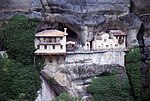
|
Other sites (sketes, hermitages, rocks, etc.) include:
| Site | Notes | Image |
|---|---|---|
| Dupiani (Δούπιανη) | Rock with the first monastery (or Skete of the Holy Virgin of Dupiani [bg]), also known as the Panagia Parthénos Kyriákou Monastery (39°43′16″N 21°37′10″E / 39.721072°N 21.619516°E / 39.721072; 21.619516 (Panagia Parthenos Kyriakou)), founded in Meteora, and also the name of the rock on which it is built. The original monastery itself has not survived. The early 13th-century chapel built on this site is still in use and maintained. Renovations took place in 1867 and 1974. Located on the north side of Kastraki village. The Monastery of St. Dimitrios of Dupiani (39°43′20″N 21°37′17″E / 39.722322°N 21.621405°E / 39.722322; 21.621405 (Monastery of St. Dimitrios of Dupiani)) at Dupiani is not to be confused with the Monastery of St. Dimitrios adjacent to Ypapantis Monastery. | 
|
| Agiou Pneuma [bg] ("Holy Spirit"; Greek: Αγίου Πνεύματος, romanized: Agiou Pneumatos) | Rock monastery with ruins (39°43′06″N 21°37′30″E / 39.718285°N 21.625010°E / 39.718285; 21.625010 (Agiou Pneuma)) connected by a narrow rock-carved path. Preserved sarcophagus, monastic cells, two cisterns, and a rock-carved altar and shrine. | 
|
| Monks' Prison (Filakaé Monakón) | The Monks' Prison (39°43′13″N 21°37′38″E / 39.720162°N 21.627118°E / 39.720162; 21.627118 (Monks Prison)) is perched on a rock cliff on the Agion Pneuma Rock. It may be the same as the Cave of Neophytos, the founder of the St. Dimitrios and Pantokrator monasteries on Dupiani Rock. Also known as Oglas (Ογλάς) or the Nuns' Prison (Φυλακές των Καλογέρων, Fylakes ton Kalogeron). | 
|
| Hermitage of St. Athanasius of Meteora (Greek: Άγιος Αθανάσιος) | Ruins of a hermitage on the Holy Spirit Rock said to be inhabited by St. Athanasios the Meteorite (Ἀθανάσιος ὁ Μετεωρίτης) (39°43′02″N 21°37′21″E / 39.717172°N 21.622431°E / 39.717172; 21.622431 (Hermitage of St. Athanasius of Meteora)). The Cave of St. Athanasius of Meteora (39°43′26″N 21°37′41″E / 39.724027°N 21.627965°E / 39.724027; 21.627965 (Cave of St. Athanasius of Meteora)) is next to the Holy Monastery. | |
| Pyxari (Πυξάρι) | Rock with cave hermitages perched on cliffs, formerly inhabited by ascetics. Located at the southwestern edge of the Meteora rock complex. | 
|
| Ambaria (Αμπάρια) | Rock with cave hermitages perched on cliffs, formerly inhabited by ascetics. Located at the southwestern edge of the Meteora rock complex. | 
|
| Monastery of St. Eustratius (Moni Agios Efstratios, Μονή Αγίου Ευστρατίου) | Little-known monastery on Surloti Rock (βράχου Σουρλωτή). | 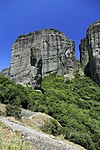
|
| Staircase of St. Eustratius | The Staircase of St. Eustratius (39°43′02″N 21°38′04″E / 39.717349°N 21.634427°E / 39.717349; 21.634427 (Staircase of St. Eustratius)) is located on the eastern side of St. Eustratios Rock. There are a few different stairways carved into the rock. | 
|
| Monastery of Theostiriktos (Μονή Θεοστηρίκτου) | Location uncertain. In the general area of Stylos Stagios (βράχου Στύλος Σταγών) / Agion Pneuma Rock. | |
| Cell of Constantius (Κελί του Κωνστάντιου) | Northeast of Pyxari Rock in a forested valley (39°42′51″N 21°37′30″E / 39.7142225°N 21.6249977°E / 39.7142225; 21.6249977 (Cell of Constantius)). Also called the Panagia Hermitage (Ασκητήριο της Παναγίας), Panagia Chapel (Ναός της Παναγίας), or Trani Church (Τρανή Εκκλησιά). | 
|
| Monastery of St. Nicholas of Petra (Μονή Αγίου Νικολάου της Πέτρας) | Ruins (39°42′39″N 21°37′16″E / 39.710824°N 21.621164°E / 39.710824; 21.621164 (Monastery of St. Nicholas of Petra)) on Badovas / Bantova Rock, just to the west of the monastery of St. Nicholas of Badova. Also known as the Monastery of St. Nicholas of Skala (Αγίου Νικολάου της Σκάλας). | 
|
| Kelarakia (Κελαράκια) | Ruins (39°43′31″N 21°37′57″E / 39.72514°N 21.63241°E / 39.72514; 21.63241 (Kelarakia)) on a rock directly to the east of the Monastery of Varlaam. The Cell of St. Paul the Apostle (Κελί του Αγίου Αποστόλου Παύλου) can probably be identified with Kelarakia. The Plakes (Πλάκες) area, a valley with various rocks, is located just south of Kelarakia. | 
|
| Monastery of the Three Hierarchs (Μονή των Τριών Ιεραρχών) | Somewhere to the east of Kastraki. Exact location unknown. |
The Great Meteoron
Main article: Monastery of Great Meteoron

The Holy Monastery of Great Meteoron is the oldest and largest of the monasteries of Meteora. The monastery is believed to have been built just before the mid 14th century by a monk from Mount Athos named Saint Athanasios the Meteorite. He began the build with a church in dedication to the Mother of God, the Virgin Mary. He later added small cells so that monks could concentrate and live atop the rock formations. The monastery's second name is, The Holy Monastery of the Transfiguration, which got its name from the second church St. Meteorites built. The successor of Saint Athanasios was Saint Joasaph, who continued to build more cells, a hospital, and renovated the churches atop the rocks. The Monastery thrived in the 16th century when it received many imperial and royal donations. At the time it had over three hundred monks living and worshipping within its cells. It is still a living monastery as there were three monks in residence as of 2015.
Being the largest among all the monasteries allows it to have a particular layout filled with many buildings. The katholikon is dedicated to the Transfiguration of Jesus and was the first church of the monastery. The hermitage of the first founder of the monastery is a small building carved in rock. The kitchen or what is commonly referred to as the hestia is a dome-shaped building near the refectory. There is also a hospital, with its famous roof of the ground floor made of brick and supported on four columns. The three old churches or chapels include: The Chapel of Saint John the Baptist which lies next to the katholikon sanctuary, The Saints Constantine and Helen Chapel which is an aisle-less church with large vault, and finally the chapel of Virgin Mary situated in the cave.
Monastery of Varlaam
Main article: Monastery of Varlaam
The Monastery of Varlaam is the second largest monastery of Meteora. The name Varlaam comes from a monk named Varlaam who scaled the rocks in 1350 and began construction on the monasteries. Varlaam built three churches by hoisting materials up the face of the cliffs. After Varlaam's death, the monastery was abandoned for two hundred years until two monk brothers, Theophanes and Nektarios Apsarades, came to the rock in the 16th century and began to rebuild the churches in October 1517. The two brothers from Ioannina spent twenty-two years hoisting materials to the top of the rock formation, however, the building only is reported to have taken around twenty days. Monks have been present since the 16th century, however, there has been a constant decline in their presence since the 17th century. Today the monastery is accessed through a series of ladders that scale the north side of the rock. The museum is open to travelers and contains a wide array of relics and ecclesiastical treasures. As of 2015 there are seven monks remaining in Varlaam.
Monastery of Rousanou
Main article: Monastery of Rousanou
The Monastery of Rousanou is believed to have been constructed, like many of the other monasteries, in the 14th century. The cathedral is believed to have been built in the 16th century and later decorated in 1540. The name Rousanou is believed to come from the first group of monks who settled on the rock from Russia. The monastery sits on the elevation 484 meters. Lying in the middle of the site, visitors can see the other monasteries, as well as the ruins of the Monastery of St. John the Baptist and the Pantokrator.
Monastery of St. Nicholas Anapausas
Main article: Monastery of St. Nicholas Anapausas
The Monastery of St. Nicholas Anapausas is located atop a small narrow rock. It is approximately eighty meters high and the first which the pilgrims encounter on their way to the holy Meteora. The Monastery was founded in the late 14th century and today is surrounded by the deserted and ruined monasteries of St. John Prodromos, the Pantocrator, and the chapel of Panagia Doupiani. The monastery served as a resting place for pilgrims and quickly got its name of Anapausas (modern pronunciation anapafseos), 'resting'. Being on such a narrow surface, the floors are connected through an interior staircase. St. Nicholas is honored on the second floor where the katholikon is located. On the third floor, there is the Holy Table and the walls are decorated by 14th-century frescoes. The monastery has been restored in the 16th century and again in the 1960s.
Monastery of the Holy Trinity
Main article: Monastery of the Holy Trinity, Meteora
The Monastery of the Holy Trinity is believed to have been built in the 14th and 15th century. Even prior to this, ancient Greeks established hermitages at the base of the rock cliffs. In the 14th century, John Uroš moved to the Meteora and endowed and built monasteries on top of the rock cliffs. He offered the sanctuaries as a safe haven during times of political upheaval. The monk Dometius was said to be the founder of the monastery, arriving at the site of Holy Trinity in 1438. The actual monastery is believed to have been built between 1475 and 1476. Some do say that the exact construction date of the monastery like many of the other monasteries is unknown. By the end of the 16th century this was one of the last six monasteries still atop the Meteora.

Monastery of St. Stephen
Main article: Monastery of Saint Stephen (Meteora)The Monastery of St. Stephen is located on a plateau-like structure. The original monastery was believed to have been built in the 14th century, however, a new katholikon was built in 1798 making it the newest of all the meteorite structures. The monastery is made up of many buildings including new katholikon, the "hestia" (kitchen), an old refectory that has since become a museum, and an assortment of rooms with different purposes. These include workrooms for paintings, embroidery, incense-making, and needlework. The church's interior was decorated with frescoes on the inside for a short period after 1545. However, During the World wars, the monasteries were bombed heavily and ransacked in the belief that the monks were holding refugees. As of 2015, the Monastery of St. Stephen is home to 28 nuns after its conversion to a nunnery in 1961.
Gallery
-
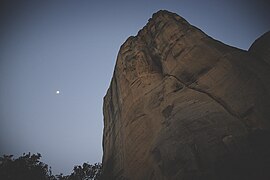 Meteora in the early morning hours
Meteora in the early morning hours
-
The Rousanou, the Nikolaos and the Grand Metereon monasteries
-
 The Monastery of Rousanou (in order from background to foreground). The Holy Spirit Rock is on the left side, while Dupiani Rock can be seen in the center, at the middle of the valley.
The Monastery of Rousanou (in order from background to foreground). The Holy Spirit Rock is on the left side, while Dupiani Rock can be seen in the center, at the middle of the valley.
-
 Panorama of the Meteora valley
Panorama of the Meteora valley
-
 Panoramic view at Meteora valley
Panoramic view at Meteora valley
-
 Panoramic view at the Monastery of Varlaam
Panoramic view at the Monastery of Varlaam
-
 Panoramic view at the Monastery of Roussanou
Panoramic view at the Monastery of Roussanou
-
 Panoramic view at monasteries of Varlaam and Grand Meteoron. From left to right: Kelarakia, Varlaam Monastery, Holy Monastery, Ypsilotera, Devil's Tower, and Grand Meteoron.
Panoramic view at monasteries of Varlaam and Grand Meteoron. From left to right: Kelarakia, Varlaam Monastery, Holy Monastery, Ypsilotera, Devil's Tower, and Grand Meteoron.
Recreation
Meteora is popular with hikers, trail runners, mountain bikers, and rock climbers from around the world, particularly during the summer. The Meteora MTB Race, also known as the Vasilis Efstathiou (Βασίλης Ευσταθίου) MTB Race, is held annually at Meteora.
In popular culture
- The monastery of Holy Trinity was a filming location for the 1981 James Bond movie For Your Eyes Only.
- The 1957 film Boy on a Dolphin is partly shot in Meteora. Clifton Webb's character visits Meteora, and goes up to the Holy Trinity monastery to do some library research.
- Scenes in Tintin and the Golden Fleece were also shot at the Meteora monasteries.
- Michina, the main setting of the movie Pokémon: Arceus and the Jewel of Life, is based on Meteora.
- Meteora is the main location in the fiction book The Spook's Sacrifice, by English author Joseph Delaney.
- One of the surviving characters in Max Brooks's zombie apocalypse novel World War Z finds refuge and peace of mind in the monasteries during and after the zombie war.
- The 2012 film Meteora, directed by Spiros Stathoulopoulos, is set in the monasteries and scenery of Meteora.
- The primary location and name of Volume 3 in the comic book series Le Décalogue by French author Frank Giroud is based on Meteora.
- The Call of Duty: Modern Warfare 3 DLC Map "Sanctuary" is set in the monasteries of the Meteora.
- The 2003 album by Linkin Park takes its name from the site.
- The monasteries were a filming location for the 1976 action movie Sky Riders. starring Susannah York, James Coburn and Robert Culp.
- In The Young Indiana Jones Chronicles episode "Travels with Father", Indiana and his father visit Meteora.
- Meteora served as an inspiration for the Eyrie in the Game of Thrones television series.
- The design of the Elysium realm in The Fate of Atlantis downloadable chapter of Assassin's Creed Odyssey was inspired by the geology of Meteora.
- Meteora was the location of the first challenge in the eighth season of the Belgian reality show De Mol.
- A professional wrestling move innovated by CIMA was named after the Meteora, as that was where he had proposed to his wife.
- The external design of the level "St. Francis' Folly" in the 1996 game Tomb Raider and its 2007 remake was inspired by the lofty monasteries of Meteora.
References
- "Meteora". Oxford Living Dictionaries. Archived from the original on 29 August 2017.
- ^ Sofianos, D.Z.: "Metéora". Holy Monastery of Great Meteoro, 1991.
- ^ Y. Facorellis, N. Kyparissi-Apostolika and Y. Maniatis 2001 The cave of Theopetra, Kalambaka: radiocarbon evidence f Radiocarbon 43 (2B): 1029–48
- ^ Alexis G. C. Savvides (1998), "Splintered medieval hellenism: The semi-autonomous state of Thessaly (AD 1213/1222 to 1454/1470) and its place in history", Byzantion, 68 (2), Peeters Publishers: 406–418, JSTOR 44172339
- Nicol, Donald MacGillivray. Meteora : The Rock Monasteries of Thessaly by Donald M Nicol. Chapman and Hall, 1963. EBSCOhost, search-ebscohost-com.holycross.idm.oclc.org/login.aspx?direct=true&db=cat06787a&AN=chc.b1193287&site=eds-live&scope=site. p. 1-2
- "Meteora". Unesco World Heritage Centre. Retrieved 29 October 2022.
- Henry Holland (7 June 2012). Travels in the Ionian Isles, Albania, Thessaly, Macedonia, Etc.: During the Years 1812 and 1813. Cambridge University Press. pp. 241–. ISBN 978-1-108-05044-9.
- ^ Rassios, Anne Ewing; Ghikas, Dina; Dilek, Yildirim; Vamvaka, Agni; Batsi, Anna; Koutsovitis, Petros (28 September 2020). "Meteora: a Billion Years of Geological History in Greece to Create a World Heritage Site". Geoheritage. 12 (4). Springer Science and Business Media LLC: 83. Bibcode:2020Geohe..12...83R. doi:10.1007/s12371-020-00509-9. ISSN 1867-2477. S2CID 221986191.
- "General info about Meteora". Meteora-Greece com.
- "Cave of Theopetra will remain closed – VisitMeteora.travel". 30 June 2016.
- Theopetra's Prehistoric Cave from Visit Meteora Travel. Retrieved 26, Jul 2013.
- Archived 6 December 2014 at the Wayback Machine
- ^ Hellander, Paul (2008). Greece. Footscray, Vic.: Lonely Planet. ISBN 978-1-74104-656-4. OCLC 182664010.
- ^ "Holy Monastery of Saint Nicholas Anapafsas." Kalampaka.com, 10 July 2016.
- "Meteora". www.beautifulworld.com. Retrieved 27 September 2016.
- ^ Hammond, Peter (1965). "Meteora: the Rock Monasteries of Thessaly. By Donald M. Nicol. London: Chapman & Hall, 1963". The Journal of Ecclesiastical History. 16 (2). Cambridge University Press (CUP): 229. doi:10.1017/s0022046900054099. ISSN 0022-0469. S2CID 161659078.
- ^ "Holy Monastery of Varlaam." Kalampaka.com, 10 July 2016, https://www.kalampaka.com/en/meteora-monasteries/monastery-of-varlaam/ .
- "Greece Meteora – Travel with a Challenge". travelwithachallenge.com. Archived from the original on 5 September 2013. Retrieved 3 April 2018.
- Bruce B. Janz (29 April 2017). Place, Space and Hermeneutics. Springer. pp. 67–. ISBN 978-3-319-52214-2.
- "Meteora, Connecting with Heaven presented in History section". www.newsfinder.org. Archived from the original on 24 May 2014. Retrieved 3 April 2018.
- "Regina Maria, prima femeie la Marea Meteoră. Fotografii inedite din interiorul mănăstirii, făcute chiar în timpul vizitei reginei :: Spiritualitate :: Calea, adevarul si viata :: Revista Felicia". Archived from the original on 19 April 2015. Retrieved 19 April 2015.
- "Damaged in World War II – World Heritage Site – Pictures, Info and Travel Reports".
- "8 κορυφαία αξιοθέατα σε Μετέωρα – 2022". Tripnholidays (in Greek). Retrieved 2 June 2022.
- OpenStreetMap.
- "Meteora, Rock climbing". theCrag. 11 May 2016. Retrieved 3 June 2022.
- ^ "Μετέωρα: Ικριωματικά καταφύγια" (PDF). Δημοκρίτειο Πανεπιστήμιο Θράκης (Τμήμα Αρχιτεκτόνων Μηχανικών). December 2019. Retrieved 8 June 2022.
- "Node: Δούπιανη (1333712611)". OpenStreetMap. 10 May 2020. Retrieved 3 June 2022.
- "Meteora-Doupiani". Vertical-Life. Retrieved 3 June 2022.
- "Meteora-Holy Ghost". Vertical-Life. Retrieved 3 June 2022.
- "Meteora-Delta Spur". Vertical-Life. Retrieved 3 June 2022.
- "Node: 4382627843". OpenStreetMap. 22 February 2020. Retrieved 21 June 2022.
- "Meteora-Sourloti". Vertical-Life. Retrieved 3 June 2022.
- "Node: Άλτσος / Άλσος (3830643354)". OpenStreetMap. 26 April 2020. Retrieved 3 June 2022.
- "Way: Πυξάρι (629598668)". OpenStreetMap. 28 May 2022. Retrieved 3 June 2022.
- Map of Monasteries, Meteora. Baedeker, PlanetWare.
- "Node: Μπάντοβας (3830668064)". OpenStreetMap. 26 April 2020. Retrieved 3 June 2022.
- "Node: Αμπάρια (1333712546)". OpenStreetMap. 26 April 2020. Retrieved 3 June 2022.
- "Meteora-Ambaria". Vertical-Life. Retrieved 3 June 2022.
- "ΜΕΤΕΩΡΑ". users.sch.gr (in Greek). Retrieved 2 June 2022.
- ^ Provatakis, Theocharis M. (2006). Meteora: History of monasteries and monasticism. Athens: Michalis Toubis Publications S.A. ISBN 960-540-095-2.
- ^ Vlioras, Spyridon (2017). "Μετεωρικές μονές: Συμβολή στον απαιτούμενο και ευκταίο διάλογο". Σπυρίδων Βλιώρας (Προσωπική ιστοσελίδα) (in Greek). Retrieved 2 June 2022.
- Bourlis Alexios (archimandrite), The Holy Monastery of Panagia of Meikani. The monastery of Paleopanagia Vlachava, Athens 2009. // Μπουρλής Αλέξιος (αρχιμανδρίτης), Η Ιερά Μονή Παναγίας της Μήκανης. Το μοναστήρι της Παλαιοπαναγιάς Βλαχάβας, Athens 2009.
- "Node: Άγιος Δημήτριος (4332250541)". OpenStreetMap. 4 May 2020. Retrieved 3 June 2022.
- "Ερειπωμένα ναι, ξεχασμένα όχι! Μια αναφορά στις Μετεωρίτικες μονές των Αγίων Αποστόλων". ΒΗΜΑ ΟΡΘΟΔΟΞΙΑΣ (in Greek). Retrieved 3 June 2022.
- Sofianos Z. Dimitrios, Deriziotis Lazaros, The Holy Monastery of Ipapanti of Meteora. Academy of Athens, 2011, ISBN 978-960-404-218-0. // Σοφιανός Ζ. Δημήτριος, Δεριζιώτης Λάζαρος, Η Ιερά Μονή της Υπαπαντής των Μετεώρων. Δεύτερο μισό του 14ου αιώνα, εκδ. Ακαδημία Αθηνών, 2011, σελ. 184, ISBN 978-960-404-218-0.
- Sofianos Z. Dimitrios, The Hosios Athanasios the Meteorite: Life, sequence, synaxaria. Prolegomena, translation of the Life, critical edition of texts, ed. of I.M.M. Meteoros (Metamorphosis), Meteora 1990, no. 21. // Βέης Νικόλαος, «Συμβολή εις την ιστορία των μονών των Μετεώρων», Βυζαντίς 1, 1909, σελ. 236, 274–276.
- "Node: Κελί του Κωνστάντιου (4382301210)". OpenStreetMap. 26 April 2020. Retrieved 3 June 2022.
- Nicol, Donald MacGillivray. Meteora : The Rock Monasteries of Thessaly by Donald M Nicol. Chapman and Hall, 1963. EBSCOhost, search-ebscohost-com.holycross.idm.oclc.org/login.aspx?direct=true&db=cat06787a&AN=chc.b1193287&site=eds-live&scope=site. p. 3
- ^ "Meteora Tourist Information". Visit Meteora. 30 November 2015. Retrieved 2 December 2021.
- ^ Poulios, Ioannis. Living Sites : The Past in the Present : The Monastic Site of Meteora, Greece : Towards a New Approach to Conservation. Jan. 2008. EBSCOhost, search-ebscohost-com.holycross.idm.oclc.org/login.aspx?direct=true&db=edsble&AN=edsble.503480&site=eds-live&scope=site. p149
- Poulios, Ioannis. Living Sites : The Past in the Present : The Monastic Site of Meteora, Greece : Towards a New Approach to Conservation. Jan. 2008. EBSCOhost, search-ebscohost-com.holycross.idm.oclc.org/login.aspx?direct=true&db=edsble&AN=edsble.503480&site=eds-live&scope=site. p15
- "Look inside Meteora, a Remote Complex of Monasteries Built Thousands of Feet above the Ground in Greece." The Business Insider (Blogs on Demand), June 2020. EBSCOhost, search-ebscohost-com.holycross.idm.oclc.org/login.aspx?direct=true&db=edsgao&AN=edsgcl.655327382&site=eds-live&scope=site.
- Nicol, Donald MacGillivray. Meteora : The Rock Monasteries of Thessaly by Donald M Nicol. Chapman and Hall, 1963. EBSCOhost, search-ebscohost-com.holycross.idm.oclc.org/login.aspx?direct=true&db=cat06787a&AN=chc.b1193287&site=eds-live&scope=site. p. 78
- Nicol, Donald MacGillivray. Meteora : The Rock Monasteries of Thessaly by Donald M Nicol. Chapman and Hall, 1963. EBSCOhost, search-ebscohost-com.holycross.idm.oclc.org/login.aspx?direct=true&db=cat06787a&AN=chc.b1193287&site=eds-live&scope=site. pg. 135–137
- Nicol, Donald MacGillivray. Meteora : The Rock Monasteries of Thessaly by Donald M Nicol. Chapman and Hall, 1963. EBSCOhost, search-ebscohost-com.holycross.idm.oclc.org/login.aspx?direct=true&db=cat06787a&AN=chc.b1193287&site=eds-live&scope=site. pg. 144
- Nicol, Donald MacGillivray. Meteora : The Rock Monasteries of Thessaly by Donald M Nicol. Chapman and Hall, 1963. EBSCOhost, search-ebscohost-com.holycross.idm.oclc.org/login.aspx?direct=true&db=cat06787a&AN=chc.b1193287&site=eds-live&scope=site. pg 147
- "Holy Monastery of Rousanou." Kalampaka.com, 10 July 2016.
- Nicol, Donald MacGillivray. Meteora : The Rock Monasteries of Thessaly by Donald M Nicol. Chapman and Hall, 1963. EBSCOhost, search-ebscohost-com.holycross.idm.oclc.org/login.aspx?direct=true&db=cat06787a&AN=chc.b1193287&site=eds-live&scope=site. p. 158
- "Holy Monastery of Holy Trinity." Kalampaka.com, 10 July 2016, https://www.kalampaka.com/en/meteora-monasteries/monastery-of-holy-trinity/ .
- Conder, Josiah (1830). Turkey. J. Duncan. p. 348.
- ^ "Holy Monastery of Saint Stephen." Kalampaka.com, 10 July 2016, https://www.kalampaka.com/en/meteora-monasteries/monastery-of-saint-stephen/ .
- Nicol, Donald MacGillivray. Meteora : The Rock Monasteries of Thessaly by Donald M Nicol. Chapman and Hall, 1963. EBSCOhost, search-ebscohost-com.holycross.idm.oclc.org/login.aspx?direct=true&db=cat06787a&AN=chc.b1193287&site=eds-live&scope=site. p. 164-166
- "Meteora MTB Race – Βασίλης Ευσταθίου". cyclinghellas.gr (in Greek). Retrieved 2 June 2022.
- "For Your Eyes Only (1981)". Retrieved 3 April 2018 – via www.imdb.com.
- "Boy on a Dolphin (1957) – IMDb". IMDb.
- Hodgson, Mark (17 December 2010). "BLACK HOLE REVIEWS: SKY RIDERS (1976) – best ever hang gliding action movie..." blackholereviews.blogspot.com. Retrieved 3 April 2018.
- A breathtaking spot in Greece served as inspiration for 'Game of Thrones'
- Debi, Eline (8 March 2020). "'De Mol': een advocaat zonder geweten en een (verdacht) blinde mol in aflevering 1" ['De Mol': a lawyer without conscience and a (suspected) blind mole in episode 1]. Flair (in Dutch). Retrieved 10 March 2020.
Further reading
- Fotis, Kotopoulis (1973). Meteora (- Kastraki – Aiginion). Athens: Difros. // Κοτοπούλης Φώτης, Μετέωρα (- Καστράκι – Αιγίνιον), εκδ. Δίφρος, Athens 1973.
- Ioannis, Papasotiriou (1934). Meteora, Trikala: Panourgia. // Παπασωτηρίου Ιωάννης, Τα Μετέωρα, εκδ. Πανουργιά, Τρίκαλα 1934.
- Ioannis, Papasotiriou, The Meteora, ed. Panourgia, Trikala 1934. // Παπασωτηρίου Ιωάννης, Τα Μετέωρα, εκδ. Πανουργιά, Τρίκαλα 1934.
- Nikolaos, Vais, "Contribution to the history of the monasteries of Meteora", Byzantius 1, 1909, p. 236, 274–276. // Βέης Νικόλαος, «Συμβολή εις την ιστορία των μονών των Μετεώρων», Βυζαντίς 1, 1909, σελ. 236, 274–276.
- Nikolaos, Vais, "Serbian and Byzantine letters of Meteora", Byzantius 2 (1910/11) pp. 89–96. // Βέης Νικόλαος, «Σερβικά και Βυζαντιακά γράμματα Μετεώρου», Βυζαντίς, 2 (1910/11) σελ. 89–96 & Σπανός Βασίλειος, Ιστορία-Προσωπογραφία της Β.Δ. Θεσσαλίας το β' μισό του ΙΔ' αιώνα, Λάρισα 1995.
- Reader's Digest. Strange Worlds Amazing Places (1994), 432 pp. Published: Reader's Digest Association Limited, London. ISBN 0-276-42111-6.
- Spyridon, Vlioras (2017). Holy Meteora – The rocks that neighbour heaven, trans. Caroline Makropoulos. Athens: Militos (Μίλητος). ISBN 978-960-464-925-9.
- Theotokni , Nun (2010). The stone forest of Meteora, vol. 1, Meteora: Holy Ascetic. // Θεοτέκνη μοναχή. Το Πέτρινο Δάσος των Μετεώρων, τ. αʼ: Ιερά ασκητήρια. Άγια Μετέωρα: Ιερό Κοινόβιο Αγίου Στεφάνου. 2010. ISBN 978-960-86366-5-1.
- Vasilios, Spanos History-Prosopography of NW Thessaly in the second half of the 14th century, Larissa 1995. // Σπανός Βασίλειος, Ιστορία-Προσωπογραφία της Β.Δ. Θεσσαλίας το β' μισό του ΙΔ' αιώνα, Λάρισα 1995.
- Βλιώρας Σπυρίδων, Ἱερὰ Μονὴ Ρουσάνου – Ἅγια Μετέωρα: Οἱ οὐρανογείτονες βράχοι, εκδ. Μίλητος, Αθήνα 2017, σελ. 178, ISBN 978-960-464-911-2.
External links
Map all coordinates using OpenStreetMapDownload coordinates as:
- "Meteora" . Encyclopædia Britannica. Vol. XVI (9th ed.). 1883. p. 114.
- Meteora beyond monasteries: a unique place in central Greece
- The Meteora monasteries
- Suspended in the air | Meteora timelapse video of Meteora
- Natural History Museum of Meteora and Mushroom Museum Kalambaka
- Meteora Trails (In 2021, an effort to map the entire trail network of Meteora began, which now consists of 14 interconnected trails covering the entire area.)
| Active monasteries | |
|---|---|
| Defunct monasteries | |
| Rocks | |



